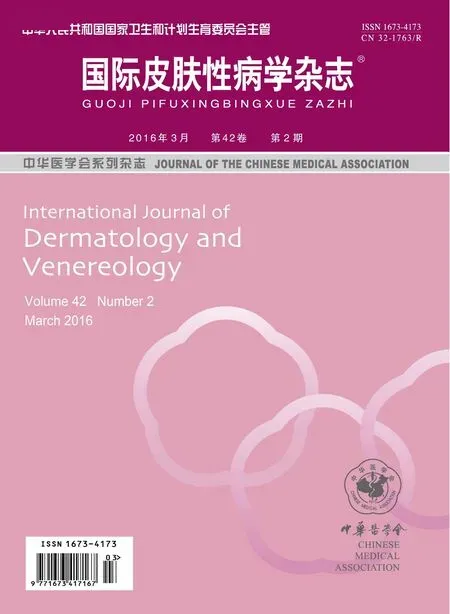固有淋巴样细胞3与银屑病的研究进展
杨蓓蓓 满孝勇 郑敏
固有淋巴样细胞3与银屑病的研究进展
杨蓓蓓 满孝勇 郑敏
银屑病的发病免疫学机制是易感性基因和环境中危险因素的联合作用,激发机体固有免疫和适应性免疫的交互作用。近年来,人们逐渐认识到固有免疫系统可能参与了银屑病炎症的启动。固有淋巴样细胞主要包括3大类,其中天然细胞毒性受体阳性的固有淋巴样细胞3在皮肤固有免疫反应中发挥主要作用,并产生白细胞介素17和22,其可能与T细胞一起,参与了银屑病的发病。
银屑病;免疫;白细胞介素17;白细胞介素22;NCR+ILC3
银屑病是一种常见的慢性炎症性皮肤病,具有不同的临床表型,银屑病的免疫发病机制是基因易感性和环境中危险因素的联合作用,激发机体固有免疫和适应性免疫的交互作用[1]。固有淋巴样细胞(ILC)主要包括3大类,其中可能参与银屑病发病的是ILC3。
1 ILC
ILC是一群具有淋巴细胞形态的造血细胞,有淋巴细胞的表型特征,但缺少适应性免疫细胞的重组抗原特异性表面受体[2]。ILC家族具有多种功能,是一组效应细胞,通过释放细胞因子发挥作用,它们不仅形成了抵抗微生物侵袭的第一道防线,而且在组织的平衡和修复,免疫病理机制等方面发挥重要作用[3]。
根据ILC转录因子表达的不同、产生细胞因子的不同及功能特性,目前将ILC亚型分为3大类:ILC1:主要分泌干扰素(IFN)γ,其典型代表是自然杀伤细胞(NK细胞);ILC2:主要分泌2型细胞因子,如白细胞介素(IL)25和IL-13,其发育和功能主要依赖结合蛋白3和孤独核受体α;ILC3:主要分泌IL-17和(或)IL-22,其发育和功能主要依赖转录因子维A酸相关孤独受体γt(RORγt),其典型代表是淋巴组织诱导细胞[4]。
2 ILC3
ILC3可以根据表达的天然细胞毒性受体(NCR)的不同分类,其中表达NKp46(小鼠)/NKp44(人类)和皮肤淋巴细胞相关抗原的,称为NCR+ILC3,主要产生IL-22;不表达NKp46/NKp44的,称为NCR-ILC3,有很强的可塑性,可以转变成NCR+ILC3 或 ILC1[4]。
在IL-23和IL-1β刺激后,ILC3产生IL-17和IL-22,在人类和小鼠的组织重构、组织保护中发挥作用[5]。同时,ILC3包括淋巴组织诱导细胞,参与胚胎发育时期淋巴结的构成[6],目前已有研究表明,ILC3与炎症性肠病发病相关[7]。
3 ILC3与银屑病
一种Rag1-/-小鼠,虽然缺少T淋巴细胞和自然杀伤T(NKT)细胞,使用咪喹莫特仍能诱导出银屑病样皮炎,但是回交的Rag2-/-小鼠与IL2rg-/-小鼠(缺少ILC和NK细胞),在咪喹莫特诱导后,则未出现相同程度的银屑病样炎症[8]。
作者单位:310009 杭州,浙江大学医学院附属第二医院皮肤性病科
一项为期12 d的银屑病皮损组织培养结果显示:ILC3的数量显著增加[9]。最新研究发现,NCR+ILC3在健康人外周血及皮肤组织中含量极低,然而在体外培养的皮肤外植体中,却发现了大量的NCR+ILC3,同时在银屑病患者的外周血及皮损中,也发现了大量的NCR+ILC3,研究还显示,NCR+ILC3与银屑病严重程度(PASI评分)相关(P=0.042)[10]。另一研究结果表明,NKp44+ILC3在银屑病患者的血液中较健康对照组显著增高。超过50%的NKp44+ILC3表达皮肤淋巴细胞相关抗原,提示其皮肤归巢潜能。NKp44+ILC3在银屑病患者的非皮损部位比健康人皮肤中含量也明显增加,同时研究也提出了NCR+ILC3 与银屑病严重程度相关(PASI评分)[11],这些结果均提示了NKp44+ILC3在银屑病发病机制中的潜在作用。Ward和Umetsu[12]用新鲜的银屑病患者受累和未受累的皮肤,验证了产生IL-22的ILC3增加(最高可达4倍)。鼠柠檬酸杆菌感染模型表明,ILC3和Th2依次诱导IL-22的产生[13]。因此,虽然ILC3在数量上较少,但NCR+ILC3对肠道的功能是非减数作用的,同理,在银屑病中可能也类似。与银屑病相关的报道还有:定居在扁桃体的ILC3,在IL-1β 和IL-23作用下,产生 IL-22和IL-17A[14]。既往研究表明,银屑病患者的扁桃体有大量皮肤归巢CD4+和CD8+T细胞[15],且银屑病患者在链球菌感染后会发病或原有的皮损会加重,提示ILC3可能和T细胞一起,参与银屑病发病。
IL-22属于IL-10细胞因子家族,是Th17的效应细胞因子,IL-22受体主要在上皮组织中表达,目前认为,其能调节上皮的固有免疫,调节角质形成细胞的增殖和分化[16]。IL-22通过Stat3转录因子磷酸化介导角质形成细胞的活化,角质形成细胞中活化的Stat3与活化的T细胞共同作用,诱导K5.Stat3C转基因小鼠产生银屑病样皮损,而阻断IL-22这一通路能够抑制皮肤炎症反应的进展[17],提示IL-22能诱导银屑病样炎症。有研究表明,血清中IL-22水平、皮肤中IL-22 mRNA及IL-22+细胞数均与银屑病严重性相关[18],提示IL-22可以作为临床银屑病严重程度的标记物。
IL-23主要由巨噬细胞和树突细胞产生,其在IL-6和TGF-β刺激下,使原始T细胞分化为Th17[19],给野生型小鼠注射IL-23后,可以诱导银屑病样炎症反应,但在IL-22缺陷小鼠中,炎症反应并不明显[20]。提示IL-22介导了IL-23诱导的银屑病样炎症反应。
IL-17A是一种来源于Th17细胞的细胞因子,在自身免疫性疾病中介导炎症反应,IL-17A在银屑病细胞活化和炎症基因中起关键作用,能直接激活表皮角质形成细胞表达的40~50个基因[21]。
在银屑病患者皮损中,IL-23、IL-17A、IL-22 显著增加,而且外周血中IL-22增加与银屑病严重程度相关[22-23]。药物诱导的小鼠银屑病模型中,IL-17A和IL-22主要由ILC3和γδT细胞产生,且它们在小鼠早期银屑病斑块形成中发挥作用[8,24]。这些均表明,IL-23/IL-17A轴和IL-22在银屑病发病中起重要作用。银屑病患者皮损和血液中的NCR+ILC3产生IL-22,可能是NCR+ILC3参与银屑病发病的主要病理机制。
4 与ILC3相关的银屑病治疗
有学者用抗TNF-α单克隆抗体(阿达木单抗)治疗1例患者后,皮损炎症减轻,血液中NKp44+ILC3下降75%[11],可能抑制ILC3和相关的细胞因子。用抗IL-12/23p40单克隆抗体和抗IL-17单克隆抗体治疗银屑病,疗效显著[25-26],有效抗银屑病治疗后,患者皮损和外周血中IL-22均恢复至正常水平[27]。
ILC3作为定居在皮肤的记忆性T细胞的天然盟友,是银屑病致病因子的重要来源,银屑病皮损中这一新ILC家族的发现及他们对生物治疗的反应,提示了ILC3失调可能与银屑病发病机制相关。
[1]Lowes MA,Suárez-Fariñas M,Krueger JG.Immunology of psoriasis [J].Annu Rev Immunol,2014,32:227-255.DOI:10.1146/annurev-immunol-032713-120225.
[2]Spits H,Cupedo T.Innate lymphoid cells:emerging insights in development,lineage relationships,and function[J].Annu Rev Immunol,2012,30:647-675.DOI:10.1146/annurev-immunol-020711-075053.
[3]Mjösberg J,Bernink J,Peters C,et al.Transcriptional control of innate lymphoid cells[J].Eur J Immunol,2012,42(8):1916-1923.DOI:10.1002/eji.201242639.
[4]Spits H,Artis D,Colonna M,et al.Innate lymphoid cells:a proposal for uniform nomenclature[J].Nat Rev Immunol,2013,13(2):145-149.DOI:10.1038/nri3365.
[5]Buonocore S,Ahern PP,Uhlig HH,et al.Innate lymphoid cells drive interleukin-23-dependent innate intestinal pathology [J].Nature,2010,464(7293):1371-1375.DOI:10.1038/nature08949.
[6]Cupedo T,Crellin NK,Papazian N,et al.Human fetal lymphoid tissue-inducercellsare interleukin 17-producing precursors to RORC+CD127+natural killer-like cells [J].Nat Immunol,2009,10(1):66-74.DOI:10.1038/ni.1668.
[7]Geremia A,Arancibia-Cárcamo CV,Fleming MP,et al.IL-23-responsive innate lymphoid cells are increased in inflammatory bowel disease [J].J Exp Med,2011,208 (6):1127-1133.DOI:10.1084/jem.20101712.
[8]Pantelyushin S,Haak S,Ingold B,et al.Rorγt+innate lymphocytes and γδ T cells initiate psoriasiform plaque formation in mice [J].J Clin Invest,2012,122 (6):2252-2256.DOI:10.1172/JCI61862.
[9]Dyring-Andersen B,Geisler C,Agerbeck C,et al.Increased number and frequency of group 3 innate lymphoid cells in nonlesional psoriatic skin[J].Br J Dermatol,2014,170(3):609-616.DOI:10.1111/bjd.12658.
[10]Teunissen MB,Munneke JM,Bernink JH,et al.Composition of innate lymphoid cell subsets in the human skin:enrichment of NCR (+)ILC3 in lesional skin and blood of psoriasis patients[J].J Invest Dermatol,2014,134 (9):2351-2360.DOI:10.1038/jid.2014.146 .
[11]Villanova F,Flutter B,Tosi I,et al.Characterization of innate lymphoid cells in human skin and blood demonstrates increase of NKp44+ILC3 in psoriasis [J].J Invest Dermatol,2014,134(4):984-991.DOI:10.1038/jid.2013.477.
[12]Ward NL,Umetsu DT.A new player on the psoriasis block:IL-17A-and IL-22-producing innate lymphoid cells [J].J Invest Dermatol,2014,134(9):2305-2307.DOI:10.1038/jid.2014.216.
[13]Basu R,O′Quinn DB,Silberger DJ,et al.Th22 cells are an important source of IL-22 for host protection against enteropathogenic bacteria[J].Immunity,2012,37(6):1061-1075.DOI:10.1016/j.immuni.2012.08.024.
[14]Bernink JH,Peters CP,Munneke M,et al.Human type 1 innate lymphoid cells accumulate in inflamed mucosal tissues [J].Nat Immunol,2013,14(3):221-229.DOI:10.1038/ni.2534.
[15]Sigurdardottir SL,Thorleifsdottir RH,Valdimarsson H,et al.The association of sore throat and psoriasis might be explained by histologically distinctive tonsils and increased expression of skinhoming molecules by tonsil T cells [J].Clin Exp Immunol,2013,174(1):139-151.DOI:10.1111/cei.12153.
[16]Wolk K,Kunz S,Witte E,et al.IL-22 increases the innate immunity of tissues[J].Immunity,2004,21(2):241-254.
[17]Sano S,Chan KS,Carbajal S,et al.Stat3 links activated keratinocytes and immunocytes required for development of psoriasis in a novel transgenic mouse model[J].Nat Med,2005,11(1):43-49.
[18]Boniface K,Guignouard E,Pedretti N,et al.A role for T cellderived interleukin 22 in psoriatic skin inflammation[J].Clin Exp Immunol,2007,150(3):407-415.
[19]Liang SC,Tan XY,Luxenberg DP,et al.Interleukin (IL)-22 and IL-17 are coexpressed by Th17 cells and cooperatively enhance expression of antimicrobial peptides [J].J Exp Med,2006,203(10):2271-2279.
[20]Zheng Y,Danilenko DM,Valdez P,et al.Interleukin-22,a T(H)17 cytokine,mediates IL-23-induced dermal inflammation and acanthosis[J].Nature,2007,445(7128):648-651.
[21]Chiricozzi A,Guttman-Yassky E,Suárez-Fariñas M,et al.Integrative responses to IL-17 and TNF-α in human keratinocytes account for key inflammatory pathogenic circuits in psoriasis[J].J Invest Dermatol,2011,131 (3):677-687.DOI:10.1038/jid.2010.340.
[22]Piskin G,Sylva-Steenland RM,Bos JD,et al.In vitro and in situ expression of IL-23 by keratinocytes in healthy skin and psoriasis lesions:enhanced expression in psoriatic skin [J].J Immunol,2006,176(3):1908-1915.
[23]Zaba LC,Cardinale I,Gilleaudeau P,et al.Amelioration of epidermal hyperplasia by TNF inhibition is associated with reduced Th17 responses [J].J Exp Med,2007,204 (13):3183-3194.
[24]Cai Y,Shen X,Ding C,et al.Pivotal role of dermal IL-17-producing γδ T cells in skin inflammation[J].Immunity,2011,35(4):596-610.DOI:10.1016/j.immuni.2011.08.001.
[25]Griffiths CE,Strober BE,van de Kerkhof P,et al.Comparison of ustekinumab and etanercept for moderate-to-severe psoriasis[J].N EnglJ Med,2010,362 (2):118-128. DOI:10.1056/NEJMoa0810652.
[26]Leonardi C,Matheson R,Zachariae C,et al.Anti-interleukin-17 monoclonal antibody ixekizumab in chronic plaque psoriasis[J].N Engl J Med,2012,366 (13):1190-1199.DOI:10.1056/NEJMoa1109997.
[27]Wolk K,Witte E,Wallace E,et al.IL-22 regulates the expression of genes responsible for antimicrobial defense, cellular differentiation,and mobility in keratinocytes:a potential role in psoriasis[J].Eur J Immunol,2006,36(5):1309-1323.
Innate lymphoid cell3 and psoriasis
YangBeibei,ManXiaoyong,ZhengMin.Department of Dermatovenereology,Second Affiliated Hospital,Zhejiang University School of Medicine,Hangzhou 310009,China
The immunopathogenesis of psoriasis involves the combined effect of predisposing genes and environmental risk factors,which excites the interaction between innate and adaptive immunity in the body.Recently,it has been gradually recognized that innate immune system takes part in the initiation of inflammation in psoriasis.Innate lymphoid cells (ILCs) mainly consist of 3 subsets,among which,natural cytotoxicity receptor-positive group 3 ILCs (NCR+ILC3) play a major role in innate immune responses in dermatitis.NCR+ILC3 can produce interleukin 17 (IL-17) and IL-22,and participate in the occurrence of psoriasis together with T cells.
Psoriasis;Immunity;Interleukin-17;Interleukin-22;NCR+ILC3
Zheng Min,Email:minz@zju.edu.cn
2015-03-19)
10.3760/cma.j.issn.1673-4173.2016.02.005
郑敏,Email:minz@zju.edu.cn

